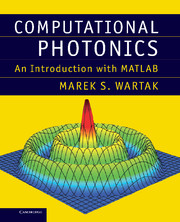Book contents
- Frontmatter
- Contents
- Preface
- 1 Introduction
- 2 Basic facts about optics
- 3 Basic facts from electromagnetism
- 4 Slab waveguides
- 5 Linear optical fibre and signal degradation
- 6 Propagation of linear pulses
- 7 Optical sources
- 8 Optical amplifiers and EDFA
- 9 Semiconductor optical amplifiers (SOA)
- 10 Optical receivers
- 11 Finite difference time domain (FDTD) formulation
- 12 Beam propagation method (BPM)
- 13 Some wavelength division multiplexing (WDM) devices
- 14 Optical link
- 15 Optical solitons
- 16 Solar cells
- 17 Metamaterials
- Appendix A Basic MATLAB
- Appendix B Summary of basic numerical methods
- Index
16 - Solar cells
Published online by Cambridge University Press: 05 July 2013
- Frontmatter
- Contents
- Preface
- 1 Introduction
- 2 Basic facts about optics
- 3 Basic facts from electromagnetism
- 4 Slab waveguides
- 5 Linear optical fibre and signal degradation
- 6 Propagation of linear pulses
- 7 Optical sources
- 8 Optical amplifiers and EDFA
- 9 Semiconductor optical amplifiers (SOA)
- 10 Optical receivers
- 11 Finite difference time domain (FDTD) formulation
- 12 Beam propagation method (BPM)
- 13 Some wavelength division multiplexing (WDM) devices
- 14 Optical link
- 15 Optical solitons
- 16 Solar cells
- 17 Metamaterials
- Appendix A Basic MATLAB
- Appendix B Summary of basic numerical methods
- Index
Summary
In this chapter we provide the fundamentals of solar cell operations. We outline basic physical principles, summarize a model based on equivalent circuit and discuss ways to increase efficiency of single-junction solar cell by employing multijunction structures or by creating intermediate bands.
General introductory books describing solar cells are [1], [2] and [3]. Anderson [1] and Rabl [2] provide a practical background in solar-energy conversion including techniques for estimating the solar radiation incident upon a collector, fundamentals of optics for solar collectors, discussion of types of concentrators and economical analysis, among others. Moeller [3] concentrates on fundamental, physical and material aspects of semiconductors for photovoltaic energy conversion.
Introduction
World consumption of electric energy circa 2009 was around 12–13 TW [4]. This energy was created by several methods. Let us look briefly at two of them: nuclear power and solar energy.
Assuming that a single nuclear plant produces 1 GW of power, creation of 10 TW of power would require 10 000 nuclear power plants. This huge number will certainly create social problems. Also, the uranium needed for those plants could be diminished in less than 20 years.
As far as the solar energy is concerned, the Sun supplies more solar energy on Earth in one hour than we use globally in one year. To make another comparison, a football field covered with silicon solar cells with an efficiency around 17% at 1-Sun illumination produces approximately 500 kW of power.
- Type
- Chapter
- Information
- Computational PhotonicsAn Introduction with MATLAB, pp. 368 - 383Publisher: Cambridge University PressPrint publication year: 2013



